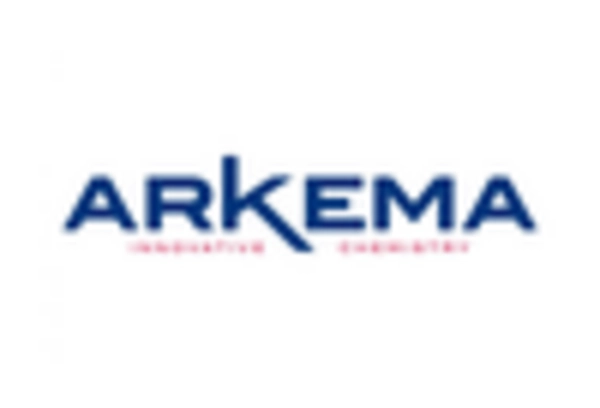Expansion of End-Use Industries
The UV Curable Resins Market is benefiting from the expansion of various end-use industries, including automotive, electronics, and construction. As these sectors grow, the demand for high-performance coatings and adhesives is also increasing. For instance, the automotive industry is increasingly utilizing uv curable resins for their durability and quick curing properties, which enhance production efficiency. In 2025, the automotive segment is expected to account for over 30% of the total market share. This growth is indicative of a broader trend where manufacturers are seeking advanced materials that can improve product performance while reducing processing times. Consequently, the expansion of these end-use industries is a significant driver for the uv curable-resins market.
Increased Investment in R&D Activities
Increased investment in research and development (R&D) activities is a key driver for the UV Curable Resins Market. Companies are recognizing the importance of innovation in maintaining competitiveness and are allocating substantial resources to develop new formulations and applications. This trend is particularly evident in the coatings and adhesives sectors, where the demand for high-performance products is on the rise. In 2025, it is projected that R&D spending in the uv curable-resins market will increase by approximately 20%, as firms aim to enhance product performance and expand their application range. This focus on R&D not only fosters innovation but also contributes to the overall growth and evolution of the uv curable-resins market.
Regulatory Support for Low-VOC Products
Regulatory support for low-VOC products is significantly influencing the UV Curable Resins Market. Government initiatives aimed at reducing air pollution and promoting sustainable manufacturing practices are encouraging the adoption of uv curable resins. In the US, various regulations are being implemented to limit VOC emissions in industrial applications, which is driving manufacturers to transition to uv curable technologies. This regulatory landscape is expected to create a favorable environment for the growth of the market, as companies seek to comply with these standards while maintaining product quality. By 2025, it is anticipated that the market will see a 15% increase in the adoption of low-VOC uv curable resins, reflecting the impact of these regulations.
Rising Demand for Eco-Friendly Solutions
The UV Curable Resins Market is experiencing a notable increase in demand for eco-friendly solutions. As industries strive to reduce their environmental footprint, the adoption of uv curable resins, which are known for their low volatile organic compound (VOC) emissions, is becoming more prevalent. This shift is particularly evident in sectors such as automotive and packaging, where sustainability is a key focus. The market is projected to grow at a CAGR of approximately 8% from 2025 to 2030, driven by the need for greener alternatives. Companies are increasingly investing in research and development to create innovative formulations that meet stringent environmental regulations, thereby enhancing their competitive edge in the uv curable-resins market.
Technological Innovations in Curing Processes
Technological innovations in curing processes are playing a crucial role in shaping the UV Curable Resins Market. Advancements in UV LED technology, for instance, are enabling faster curing times and lower energy consumption, which are appealing to manufacturers looking to optimize production efficiency. The introduction of new curing systems is expected to enhance the performance characteristics of uv curable resins, making them suitable for a wider range of applications. As of 2025, it is estimated that the adoption of UV LED technology could increase by 25%, further driving the growth of the market. These innovations not only improve the quality of the final products but also align with the industry's shift towards more sustainable practices.

















Leave a Comment